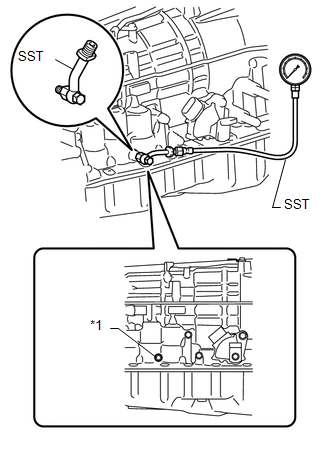HYDRAULIC TEST 1. PERFORM HYDRAULIC TEST (a) Measure the line pressure. CAUTION: The line pressure test should always be performed with at least 2 people. One person should observe the condition of the wheels and wheel chocks while the other is performing the test. NOTICE:
(1) Warm up the ATF (Automatic Transmission Fluid). (2) Turn the ignition switch off. (3) Lift the vehicle up. (4) Remove the test plug from the center of the right side of the transmission case and connect SST.  Text in Illustration Text in Illustration
SST: 09993-19015 09993-00040 09993-00010 (5) Lower the vehicle. (6) Fully apply the parking brake and chock the 4 wheels. (7) Start the engine and check the idling speed. (8) Keep your left foot pressed firmly on the brake pedal and move the shift lever to D. (9) Fully depress the accelerator pedal with your right foot. Quickly read the highest line pressure when the engine speed reaches the stall speed. (10) In the same manner, perform the test with the shift lever in R. Specified Line Pressure
|
Toyota Tundra Service Manual > Can Communication System: Lost Communication with Tilt and Telescopic Module (U1115)
DESCRIPTION DTC No. DTC Detection Condition Trouble Area U1115 There is no communication from the multiplex tilt and telescopic ECU. Outer multiplex tilt and telescopic ECU CAN branch wire or connector Power source or inside of multiplex tilt and telescopic ECU Multiplex tilt and telescopic ECU grou ...